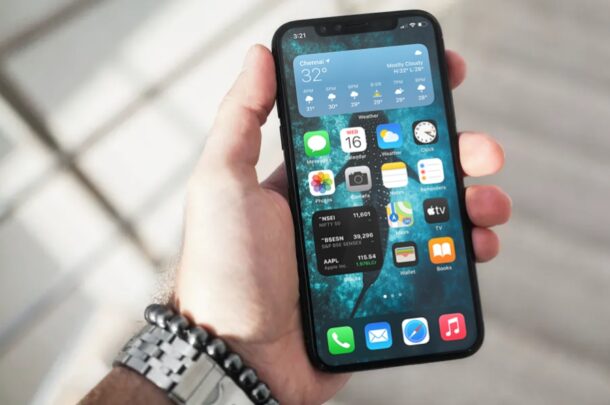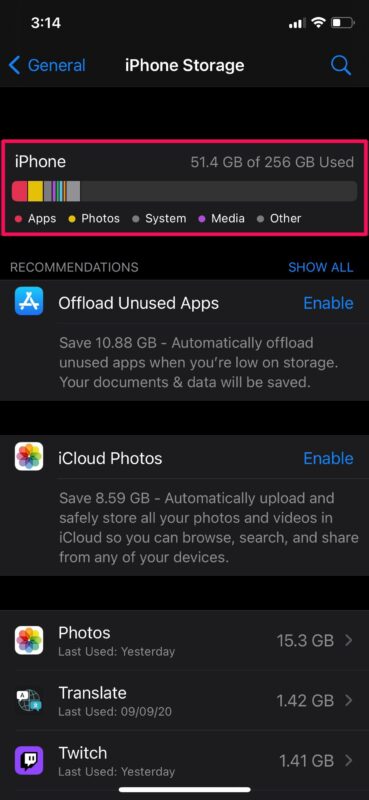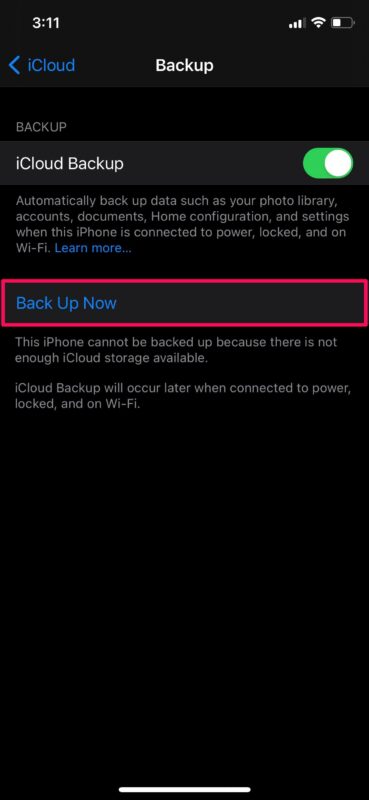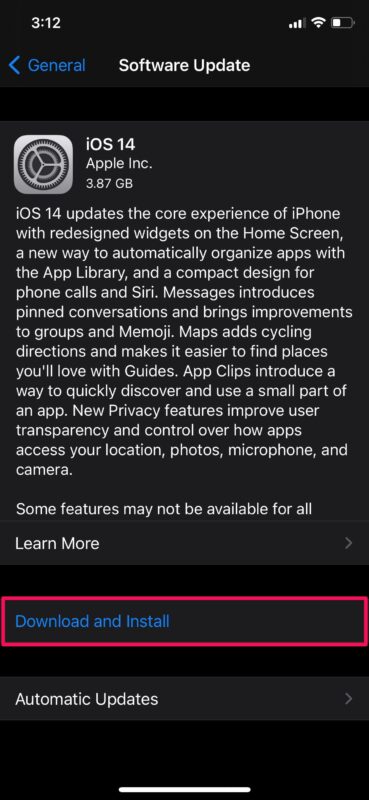How to Prepare for iOS 14 & iPadOS 14

Apple has released the first stable version of iOS 14 and iPadOS 14 to its users after months of beta testing. You might be excited to update your device to the newest iOS or iPadOS version the second you see it in settings. However, there are a few things to keep in mind before you download iOS 14 to make sure the update process goes as smoothly as possible.
1: Check Device Compatibility with iOS 14 / iPadOS 14
As is the case with every major iOS/iPadOS update, not all iPhones and iPads are capable of running the latest version of Apple’s mobile operating system.
If you use an iPhone, take a look at the official iOS 14 compatibility list to see if your model is supported. Fortunately, this time around, the iOS 14 compatibility list is pretty much identical to the list of devices capable of running iOS 13, which is an unusual move from Apple. Therefore, if you own an iPhone 6S, iPhone SE, or any newer iPhone, you’re all set for the update.
The iPadOS 14 compatibility list is identical to the iPadOS 13 compatibility list as well. The list includes models starting with the iPad Air 2 that released in late 2014. So if you have any newer iPad, you will be able to update it to the latest version of iPadOS.
All in all, if your iPhone or iPad is currently running iOS 13/iPadOS 13, you can be certain that your device is compatible with the update and you will be receiving future updates until the next iteration of the operating system.

2. Ensure Adequate Storage Space
The iOS 14/iPadOS 14 is a major software update and will require a few gigabytes of free space on your device. Make sure you have ample storage space to download and install the update file on your iPhone and iPad. Try to make 4 GB of space at the bare minimum if you’re running low on storage. Head over to Settings -> General -> iPhone (iPad) Storage to see how much space you currently have.

Consider this as an opportunity to clean up the physical storage on your device. Start with uninstalling the apps you don’t use and remove the old unwanted photos to free up space quickly.
Other ways to free up storage include offloading apps from iPhone or iPad, using automatic offloading of unused apps in iOS, and to free up storage by moving photos to a computer or iCloud and then removing videos and pictures from the device itself.
Do you have a ton of songs stored on your iPhone and iPad? In that case, cleaning up your music library by deleting some songs can also help in freeing up some storage space. You could switch to a music streaming service like Apple Music or Spotify if you don’t want songs to use up your device storage.
3. Back Up Your iPhone / iPad
This is probably the most crucial step you need to follow before installing any update on your device. Software updates can go wrong at any given time and you could potentially end up bricking your iPhone or iPad. Sometimes, you may be stuck in the Apple logo boot screen and you’ll need to restore your device, which means wiping all the data on it. In such cases, if you don’t have a backup, you will permanently lose all your data.
The most convenient way to back up the data stored on an Apple device is by using iCloud to backup your iPhone and iPad. Of course, if you’re not paying for iCloud or if you don’t have a fast enough internet connection, you can take the conventional route and back up your iOS/iPadOS device to your computer using iTunes on Windows and Mac. If your Mac is running macOS Catalina or later, you can use Finder to perform the backup.
That being said, iCloud backups are simple and quick if your Wi-Fi connection is fast and reliable. To perform an iCloud backup on your iPhone or iPad, head over to Settings -> Apple ID -> iCloud -> iCloud Backup -> Back Up Now. Keep in mind that you won’t be able to back up your device if you don’t have adequate iCloud storage space. In that case, you’ll need to upgrade your iCloud storage plan.

4. Update Your Apps
Before you update the software on your device, make sure you update all the installed apps. This is because some apps may have new features that get unlocked with the iOS 14 update. For example, you can now set Google Chrome as the default browser on your iPhone, but you’ll need to have the latest version of the app installed apart from running iOS 14.
To update your apps, launch the App Store on your iPhone or iPad and tap on your profile icon at the top-right corner of the screen. Next, scroll down and tap on “Update All” and patiently wait for the apps to finish updating.
Keep checking for app updates once you update to iOS 14/iPadOS 14 though, as app developers will continue to release compatibility updates for the latest version of Apple’s mobile operating system.

5. Install iOS 14 / iPadOS 14
Now that you’ve completed the above steps, you’re ready to update your device to iOS 14 / iPadOS 14. Whether you’re using an iPhone or iPad, you can manually check for the software update by going to Settings -> General -> Software Update. Tap on “Download and Install” to initiate the update process. Keep in mind that your device must have at least 50% battery left or be connected to a power source to begin the installation.

As of this writing, both iOS 14 and iPadOS 14 are available to the general public. If you don’t see any available updates yet, keep checking every few hours as Over-the-Air updates take a while to be delivered.
You can also download iOS 14 and iPadOS 14 IPSW if you’re the type who likes to manually install updates with firmware files.
If you want to stay ahead of the stable release of iOS 14 and iPadOS 14, you can sign up for the Apple Beta Software program and install the public beta version on to your device. However, it’s not recommended unless you’re an advanced user, since these are early experimental builds of iOS. Beta software can be unstable at times and tend to have bugs that may cause the system and installed apps to not function properly.
Should you wait for iOS 14.1, iPadOS 14.1, or later?
Sometimes, rushing right away into updating system software to the latest version may not be the best option, especially when it comes to major software updates like iOS 14 and iPadOS 14. Giving it a few days and seeing if users are reporting issues after updating their own devices is a strategy employed by some who are a bit more cautious.
Delaying major updates can help to discover if there are any major problems with the initial releases, and also gives time for Apple to iron out those (theoretical) issues with a future software update. And not updating right away may help your apps be updated for full compatibility as well.
If previous iOS and iPadOS releases are any indicator, the process of issuing corrective updates takes a couple of weeks, unless it’s a hotfix that takes just a day or two to arrive. Depending on the type of update and what the issue is, these typically show up as point releases versioned as things like iOS 14.0.1, iOS 14.1, iOS 14.1.1, iOS 14.2, iPadOS 14.1, etc.
If you have automatic updates turned on and you see that iOS 14 / iPadOS 14 is already being downloaded, you can stop the update while it’s downloading. However, once the installation begins, there’s no way to stop the update and you’ll just need to wait for your device to reboot after completion.
Are you currently installing the iOS 14 and iPadOS 14 updates on to your iPhone and iPad right away? Or, are you patient enough to play the waiting game? What are your overall thoughts on the new features and changes that the latest operating system has to offer? Do share your valuable opinions and experiences in the comments section down below.


IPad Pro.
iPadOS 14 …..Not able to download app updates.
Tap ‘update’ button..attempts to locate site but ‘update’ button returns.
Anyone got same?